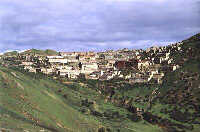|
Gandain Monastery: Cradle of the Gelug Sect
( 2005-10-27 )
The Gandain Monastery lies in Dagze County 60 kilometers to the east ofLhasain Southwest China's Tibet Autonomous Region. It is one of the "three great monasteries" in Lhasa -- the other two are Zhaibung and Sera --, and one of the six great monasteries of the Gelug Sect. The halls of the monastery spread across the top of the Wangbur Mountain give the impression of a mountain town when viewed from a distance.
Gandain means happiness and contentedness in Tibetan. The Gandain Monastery, the first and foremost Gelupka monastery, was built in 1409 under the supervision of Tsong Khapa, founder of the Gelug Sect of Tibetan . The main buildings include the Coqen Hall, the Chamber of Tsong Khapa, and the Yangbajian Zhacang (colleges for studying the sutras). . The main buildings include the Coqen Hall, the Chamber of Tsong Khapa, and the Yangbajian Zhacang (colleges for studying the sutras).
The three-story Coqen Hall is the monastery's main hall, large enough to hold a gathering of 3,000 lamas, who use the hall for sutra recitation. The main hall was not completed until 1417, two years before Tsong Khapa died, but after having announced his disciple, Gyeltsab Je, as the new leader of the Gelug Sect or Gandain Chiba.
The name Gandain Chiba refers to the head abbot of the Gandain Monastery. Since the Gandain Monastery is the ancestral monastery of the Gelug Sect, the Gandain Chiba is also the head abbot of the Gelug Sect. He is next only to the Dalai Lama and the Pachen Erdeni in terms of status in Tibetan Buddhism.
In the following years, Dama Bergin, a disciple of Tsong Khapa, built a silver stupa that now contains Tsong Khapa's remains. It was the 13th Dalai Lama who rebuilt this stupa and wrapped it in gold leaves.
When viewed from a distance, the Gandain Monastery looks very much like a castle. It was listed as one of Tibet's cultural relics under the special protection of the State in 1961.
|

